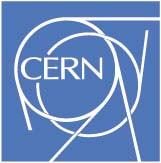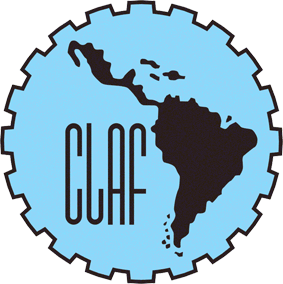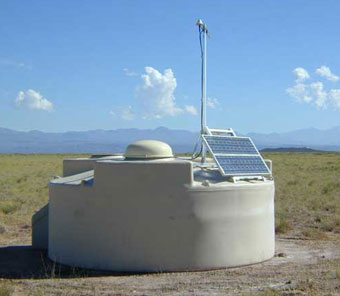 |
|
 |
 |
|
 |
The 2005 CERN-CLAF School of High-Energy Physics will be organized jointly by the European Laboratory for Particle Physics (CERN), Geneva, Switzerland and the Centro Latino Americano de Fisica (CLAF), together with Consejo Nacional de Investigaciones Cientificas y Tecnicas (CONICET), Argentina.
A "low" resolution (316kb) copy of the school announcement poster in A3 format is available at Poster_low and a higher resolution (1 Mb) at Poster_high, both in jpg format.
PLEASE NOTE THAT THE DEADLINE FOR APPLICATIONS IS 14 NOVEMBER.
The basic aim of the School is to teach various aspects of high-energy physics, and especially theoretical physics, primarily to Post-Graduates in experimental particle physics, typically aged under thirty years and about one year from submitting their Ph.D. theses. However, a few Latin American Post-Doctoral students in experimental high-energy physics and Master's Degree students in theoretical physics may be accepted, assuming their background knowledge in theoretical physics is of approximately the same level as the experimental Ph.D. students.
The Schools of Physics are designed to give a survey of up-to-date information, rather than to be a training course. An outline of each of the lecture courses and reading lists will be published on the school web pages well in advance of the school.
Letters of acceptance will be sent to the selected students.
Date and Place of the School
Accommodation
Scientific Programme
Discussion Sessions
Poster Session
Language
Proceedings
Travel and Insurance
Cost
Participation
Application
Organizing Committee
Enquiries and correspondence

Sunset over the Andes
Date and place of the School
The 3rd CERN-CLAF School of High-Energy Physics will be held in Malargüe, Argentina, from February 27 to March 12, 2005.
Malargüe is located southeast in the Province of Mendoza and has a population of 15,400 inhabitants. It is the closest town to the international ski center Las Leñas, the most important ski resort in South America and one of the most significant in the world. Horseback riding, mountain climbing, and hiking are just a few of the many diverse activities that one can enjoy while exploring the region. ( See for instance http://www.laslenas.net/malargue.html).
La Caverna de las Brujas ( the Cave of the Witches) is one of the most wonderful geological places. In the galeries of more than 5000 m, the stalactites and stalagmites acquire different shapes, dimensions and colors. No one has ever reached the end of its labyrinths.
The Laguna Llancanelo is a virgin and natural environment of great ecological value, famous for its flamingos and has also a wide variety of swans and ducks. The volcanic reservation, Payunia, is a region of amazing volcanic wasteland around extinct volcanos, showing the patagonic ecosystem in Mendoza.
Some excursions will be organized and one afternoon will be free.
The Pierre Auger Observatory

An Auger Surface Water Cerenkov Detector
The Southern Site of the Pierre Auger Observatory is located near the city of Malargüe, in a place named Pampa Amarilla, spanning across the Malargüe and San Rafael Departments. See http://www.auger.org/overview.html for information about the Obseravtory.
The Pierre Auger Observatory is the most ambitious project ever undertaken for the study of the ultra high energy cosmic rays (UHECR) with unprecedented statistical precision. The PAO has the important characteristic of being a hybrid detector, combining information from ground-based particle detectors and atmospheric fluorescence detectors to offer unprecedented opportunities to resolve the systematic errors which have plagued energy measurements in all similar experiments to date. It is our current best chance to unravel the deep mysteries surrounding these messengers from the "extreme universe" and the data are expected to shed light on physics ranging from acceleration mechanisms in space and cosmic magnetic fields, to high energy hadron physics and quantum gravity.
Accommodation
All those participating in the School will be lodged in the Río Grande hotel, located at the entrance of Malargüe, and the students will be sharing twin rooms.
The Río Grande hotel has a big restaurant, with professional staff qualified to satisfy the most demanding tastes. The hotel has common laundry service and parking space.
The lectures and discussion sessions will take place at the modern Conference Center, Thesaurus. The Center has 3 main lecture theaters, with capacity for more than 1000 people, named after the sacred Mapuches trees (Calden, Canelo and Maiten), and 4 additional rooms.(Photos of the center at http://www.malargue.gov.ar/ctro_conv.htm )
Scientific programme (draft)
The draft scientific programme is as follows:
| Field Theory and Standard Model | L. Alvarez-Gaume, CERN |
| QCD | M. Mangano, CERN |
| CP Violation and Flavour Physics | Y. Nir, Weizmann Institute |
| Beyond the Standard Model | J. Ellis, CERN |
| Neutrino Physics | W.C. Haxton, University of Washington |
| QCD with Relativistic Heavy Ions | D. Karzeev, BNL |
| Particle Astrophysics | R. Kolb, Fermilab, Chicago |
| Cosmic Ray Physics (theory) | A. Olinto, Chicago University |
| Experimental Aspects of Cosmic Rays | P. Sommers, University of Utah |
| Instrumentation for Particle Physics | S. Stapnes, Univ. of Oslo and CERN |
| Trigger and Data Acquisition | N. Ellis, CERN |
| Introduction to the Auger Experiment | A. Watson, University of Leeds, UK |
Discussion Sessions
Discussion sessions, which are intended to clarify points which may be obscure from the lectures, will be held most afternoons and will last for about 75 minutes.
The discussion sessions will be led by:
| Guillermo Contreras | Cinvestav, Merida |
| John Swain | Northeastern Univ., Boston and Costa Rica |
| Gabriel Gonzales-Sprinberg | Univ. de la Republica, Montevideo |
| Daniel Gomez Dumm | UNLP, La Plata |
| Hiroshi Nunohawa | PUC, Rio de Janeiro |
Poster Session:
Students are expected to produce and display as posters a short description of the experiment on which they are working and some recent results. They should bring with them graphs, pictures and other suitable material for display on pin boards. The evening of 3 March will be devoted to their presentation during an informal session when refreshments will be provided.
Language
The working language of the School will be English. Participants should therefore have a good understanding of English to enable them to benefit from the School.
Proceedings:
The School Proceedings will be published as a CERN Yellow Report in 2006. Each participant will receive one copy free of charge.
Proceedings from the LA School 2001 in Brazil is available at LAProceedings2001
Proceedings from earlier European schools are available at Proceedings2002 , Proceedings2001 , Proceedings2000 and Proceedings1999.
Travel and Insurance
Students should arrange to arrive in Malargüe for registration during the afternoon or evening of Sunday, February 27. The School will end on the morning of Saturday, March 12 after breakfast.
The nearest main airport is in Mendoza which can be reached from most of the airports in Argentina and from Santiago de Chile. Bus transport from Mendoza to Malargüe will be organized, and it is also planned to organize a comfortable night bus from Buenos Aires. Details of different travel possibilities and arrangements will be published later
The students should make sure that they have a valid medical insurance
Cost
The School Fee will be approximately $750 (US) per student, and will cover tuition, full board and lodging at the Hotel from dinner on Sunday 27 Ferbuary to breakfast on Saturday 12 March, with coffee, tea or cold drinks during the morning and afternoon breaks, as well as some social activities and excursions. The Fee does not include travel expenses from the participants' home institutes to Malargüe and back.
Due to generous support from Spain, Italy, France, CONICET in addition to CERN it will be possible to cover the school fees and travel expences for a good fraction of the Latin American students. However, the central funds are limited, and we would therefore hope and expect that in particular students from Mexico and Brazil would be able to cover their expenses. In that case it will be possible to cover the school fees and travel cost (at the lowest possible rate) for most of the other Latin American students who would want to attend the school.
Comments on the need for financial support should be given at the end of the application form.
Students from outside Latin America must have school fees and travel cost covered by their institutes.
Participation
The School is open to postgraduates in experimental particle physics, typically aged under thirty years and about one year from submitting their PhD theses. However, a few Latin American Post-Doctoral students in experimental high-energy physics and Master's Degree students in theoretical physics may be accepted, assuming their background knowledge in theoretical physics is of approximately the same level as the experimental PhD students. The number of students will be about 80, mostly from Latin America, although the School is also open to those from other countries and regions.
Personal contacts and informal discussions among the participants during leisure time are an important aspect of the School and, for this reason, participants are asked to note that they should not be accompanied by family members or friends.
Application
Applications to attend the School must be submitted before 14 November, 2004, and should include:
- a completed application form
- a 100-word summary of current work (part of the form)
- a letter of reference and ranking from the candidate's professor or supervisor
For the Application Form remember to fill in ALL fields: use "N/A" when "Not Applicable".
The application form should be completed and sent as soon as possible and must be received by the closing date of 14 November, 2004.
Reference Letter
The submission of the completed application form must be accompanied in parallel by a letter of reference and ranking from the student's professor or supervisor (signed and dated hard copy with letterhead of referee's institution). Applications without a reference letter will not be considered. The professor or supervisor's name and the date of the reference letter should be indicated in the appropriate boxes on the Web application form; and the letter should be sent to Danielle Métral, the CERN Organizing Secretary (see Enquiries and Correspondence below).
Students who wish to apply but who do not have a suitable browser for the Web application form should request a hard copy of the form from the Organizing Secretary (see Enquiries and Correspondence), stating clearly their name and postal address and accompanied by the 100-word summary of their current work.
Candidates should ensure that their application and letter of reference reach the CERN Organizing Secretary by 14 November 2004.
The selection of the students will be made by the Organizing Committee; and all applicants will be informed in December 2004 whether or not they have been selected.
Organizing Committee
M. Teresa Dova, UNLP, La Plata, School Director
C. Garcia Canal, UNLP, La Plata
J. Ellis (CERN)
N. Ellis (CERN)
R. Fleischer (CERN)
C. Kozameh, UNC, Cordoba
E. Lillestol (CERN and University of Bergen)
D. Métral (CERN) Organizing Secretary
R. Piegaia, UBA, Buenos Aires
E. Roulet, CAB, Bariloche
A. de Rujula, CERN
O. Sampayo, UNMdP, Mar del Plata
R. C. Shellard, CBPF, Rio de Janeiro
A. Zepeda, Cinvestav, Mexico
Enquiries and correspondence
All enquiries and correspondence related to the School of Physics should be addressed to the School Organizing Secretary:
| Danielle Métral School of Physics CERN/DSU CH-1211 GENEVA 23 Switzerland |
| Tel: +41 22 767 9141 |
| Fax: +41 22 782 3011 |
| E-mail: |